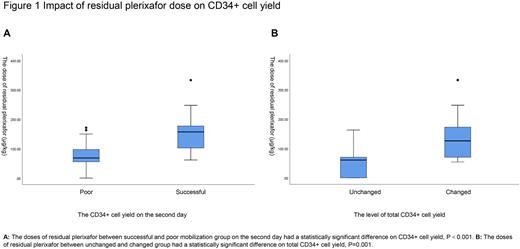Abstract
Background
Granulocyte colony-stimulating factor (G-CSF) plus plerixafor have been shown to improve the efficacy of peripheral blood stem cell (PBSC) mobilization, however, due to its high price, the use of plerixafor in China are limited.
Study Design and Methods
In this single-center retrospective study, 69 multiple myeloma (MM) patients received G-CSF + plerixafor to mobilize PBSCs, which were collected from 28 patients only for one day and 41 patients for two days. Some of the patients received the residual plerixafor who collected PBSCs on the second day. The yield of CD34+ cells in MM patients was the endpoint of this study, which was divided into 3 levels. The yield of CD34+ cells at <2×106 cells/kg, ≥2×106 cells/kg but<5×106 cells/kg, and ≥5×106 cells/kg was defined as poor, good and excellent mobilization, respectively. CD34+ cells ≥2×106 cells/kg was regarded as the minimum goal of successful mobilization. Collected and analyzed the data of characteristics, different dose of plerixafor and efficacy of PBSC mobilization.
Results
There was no statistically significant difference in the success rate of CD34+ PBSC mobilization with the different dose of plerixafor on the first day, but the higher residual plerixafor dose resulted in better success rates on the second day (P<0.001). The mean doses of residual plerixafor in the successful mobilization group and the poor mobilization group on the second day were 155.6 μg/kg and 72.2 μg/kg respectively, which indicated a statistically significant difference (P<0.001, Figure 1A). Among the patients who collected PBSCs for two days, the level of the CD34+ cell yield of 24 patients (58.5%) changed better, 11 (26.8%) in which from poor to good, and 13 (31.7%) in which from good to excellent. The mean doses of residual plerixafor in the changed group of the total yield of CD34+ cells and unchanged group were 132.3 μg/kg and 61.0 μg/kg respectively, which was significantly correlated with the dose of residual plerixafor on the second day (P=0.001, Figure 1B).
Discussion
These results suggested that the administration of residual plerixafor to mobilize stem cells on the second day is an economical, efficient and clinically feasible method.
Disclosures
No relevant conflicts of interest to declare.
Author notes
Asterisk with author names denotes non-ASH members.


